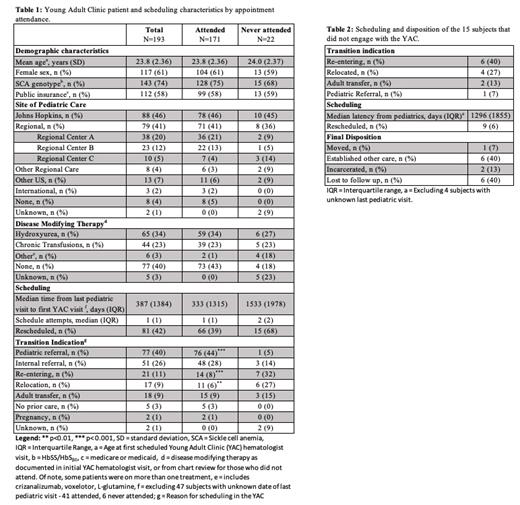Introduction
The transition from pediatric to adult care for people with sickle cell disease (SCD) is associated with multifactorial vulnerabilities including life stage of affected individuals (emerging adulthood), accumulating SCD morbidities, lack of adult specialists to provide care, and limited resources to ensure successful integration into adult care. Much of the data on transition in SCD is reported from pediatrics. The purpose of this study is to describe attendance of young adults with SCD at a young adult clinic embedded in an adult SCD center.
Methods
The Johns Hopkins IRB approved this single-center, retrospective cohort study that included all patients scheduled with the hematologist at the Young Adult Clinic (YAC) in the Sickle Cell Center for Adults at Johns Hopkins between March 1, 2019 and June 31, 2023. YAC referrals come mostly from pediatric hematology centers or Center staff who refer patients <30 years old without an assigned hematologist. The YAC has an “infinite reschedule” policy: there is no limit on rescheduling missed appointments.
We included all patients scheduled to see the YAC hematologist and captured patient demographic and SCD characteristics, referral sources, and clinic attendance. Patients' YAC referral indication was categorized as pediatric referral for aging out of care, internal referral, re-entering care, relocation, transfer from outside adult care, no prior care, or pregnancy. Subjects were classified as “attended” if they ever had a YAC visit and “never attended” if they never had a YAC visit. We compared subject characteristics using tests of proportions, non-parametric, or t-tests as appropriate.
Results
The 193 subjects with a scheduled visit were mean age 23.8+/-2.4 years, 61% female, 74% HbSS/HbSβ 0 genotypes, 58% were publicly insured, 56% received hydroxyurea or chronic transfusions, and 82% previously received care at a regional pediatric SCD care center (Table 1). For 40%, the appointment indication was pediatric referral for aging out of care.
Most scheduled subjects (89%, 171/193) attended a YAC appointment; 11% (22/193) did not. Among those who attended a visit, 61% (105/171) attended the first scheduled visit and 39% (66/171) attended rescheduled visits. The median number of rescheduled visits was 1 (IQR 1). Median days from last pediatric to first YAC visit varied by indication; It was shortest for pediatric referrals (107 days, IQR 193), longer for relocation (304 days, IQR 1022), and longest for those re-entering care (1575 days, IQR 843).
Referral from pediatrics for aging out of care was associated with 99% attendance (76/77 attended vs 1/77 never attended, p<0.001). Risks for not attending any visit included re-entering care (14/171 attended vs 7/22 never attended, p<0.001), relocation (11/171 attended vs 6/22 never attended, p<0.01), and longer time from last pediatric visit to first scheduled YAC visit (median 333 days attended vs 1533 days never attended, p<0.01). Visit attendance was not associated with age, sex, genotype, pediatric care site, insurance, SCD treatment, or reschedule attempts.
Among 22 subjects who never attended a YAC visit, 7 were seen by a Center Advanced Practice Provider (APP). Among the 15 subjects never seen in the Center (Table 2), most (N=7) were re-entering care and last pediatric visit was over 3 years (median 1296 days, IQR 1855) before scheduled YAC appointment.
In total 92% of YAC-eligible subjects engaged in SCD care, 171 with the YAC hematologist and 7 with an APP. In this cohort, there were 4 deaths and 4 successful bone marrow transplants.
Conclusion
Most young adults offered repeated opportunities to engage in comprehensive SCD care at the YAC ultimately pursue care. Rates of attendance at a specialty clinic for young adults with SCD were especially high, 99%, for referred from pediatric SCD care without no difference in attendance by sex, referral site or insurance, a proxy for socioeconomic status. Patients with care gaps are less likely to attend visits, but the low number of subjects who never attended limits conclusions. The outcomes underscore the high stakes of SCD care: most (57%) used SCD treatment, 2% died, and 2% were cured of SCD. There is overrepresentation of women in the cohort, but men and women are equally represented among clinic non-attenders. Sex-specific risk factors for continuing, or not, in SCD care need study. Resources are needed to identify and bring patients into care.
Disclosures
Pecker:Global Blood Therapeutics: Consultancy; Alexion: Research Funding; Novo Nordisk: Consultancy. Lanzkron:Pfizer: Current equity holder in publicly-traded company; Magenta: Consultancy; Novo Nordisk: Consultancy; Bluebird Bio: Consultancy; MD CHRC: Research Funding; PCORI: Research Funding; HRSA: Research Funding; CSL-Behring: Research Funding; Takeda: Research Funding; Global Blood Therapeutics: Research Funding; Novartis: Research Funding; Imara: Research Funding; Teva: Current equity holder in publicly-traded company.


